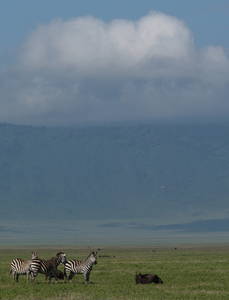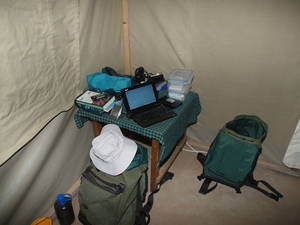Safari photography
Binoculars
The most important purchase I made for the trip was a decent pair of binoculars, a pair of Barr and Stround 8x42 binoculars bought from an Amazon UK seller. I picked these because they have good eye relief, so I can use them with my glasses, and they worked well there. They were also just really pleasant to use, with smooth focusing and movement. And they feel really solidly built, as well as being waterproof. (They also weigh around 700g, so I'm not sure how often they'll get taken hiking!)
Our guides had similar size and magnification binoculars, 8x40 or 8x42.
Camera gear
I had decided long ago that if I ever went on an African safari I would upgrade my camera and buy a good telephoto lens. I had picked up a secondhand telephoto lens some time ago, but in the end I stuck with my now aging Olympus E-1 — my only purchases was a new strap for this, as the original one had started falling apart.
For lenses, I had a 14-54mm f/2.8-3.5 (28-108 equivalent) standard zoom, a 50-200mm f/2.8-3.5 (100-400 equivalent) telephoto, and a 1.4x teleconverter. (I also had a circular polarizer and a tripod, which I didn't end up using.)
More reach would have been good occasionally, mostly for birds. At the other end, I mostly only wanted the wide-angle for buildings, food, etc. On the savannahs the 50mm to 100mm (100-200 equivalent) range was much more useful for landscapes, which were otherwise swamped by huge expanses of grass or sky. (I have proportionally far more photographs with the standard zoom jammed to 54mm than I do with the telephoto at 50mm.) So a 100-400mm equivalent zoom is probably the most useful 4x zoom for a safari.
I'm used to composing in camera and repositioning myself if necessary, so being in a vehicle with limited options for moving around to change framing was occasionally frustrating. It also meant I did much less macrophotography (of plants and other interesting ground features) than I would normally. The places where we had a chance to walk (mostly in Kenya) were pleasant changes.
The E-510 has image stabilisation and better software (replay zoom, colour histograms, etc.) but the dynamic range isn't so good and I find the ergonomics a bit frustrating.
I took a little netbook as well, which wasn't used much — to check email at the beginning, middle and end of the trip, and to vote in the NSW state elections from Arusha — and I left it in Arusha while we were on the Tanzanian leg of the trip. The chargers, etc. for all of this took up quite a bit of space, but I packed them into hard kitchen containers and that kept them manageable (and well protected).

